26.03.2020Distant learning: an opportunity for the development of education or a prerequisite for deepening educational inequalities
The coronavirus threat and the state of emergency have set an important task for school education in Bulgaria: to make a huge leap into the 21st century; the catalyst: the introduction of distant learning. The unprecedented situation, however, has posed a major challenge for the Bulgarian education system: to modernize so as not to deepen the distance in education and not to open the scissors even further between schools that teach children from vulnerable groups and schools that work with children whose parents have relatively high education and social status.
To answer these questions, and to track what are the main needs and major solutions in the first few days of introducing distant learning, Amalipe Center conducted an online survey involving nearly 200 schools, mainly from the Every Student Network will be an excellent "*. In half of them, students from vulnerable groups are between 80% and 100%, in almost 19% the proportion of students from vulnerable families is between 60% and 80%. Nearly 9% of schools do not concentrate on vulnerable groups, that is, they are below 20% of students. For the study was used the definition of vulnerable groups and MES system NEISPSE (NATIONAL ELECTRONIC INFORMATION SYSTEM preschool and school education) - namely students from families in which parents are with secondary education. We should clarify that there are around 1000 schools with a concentration of vulnerable groups on a national scale.
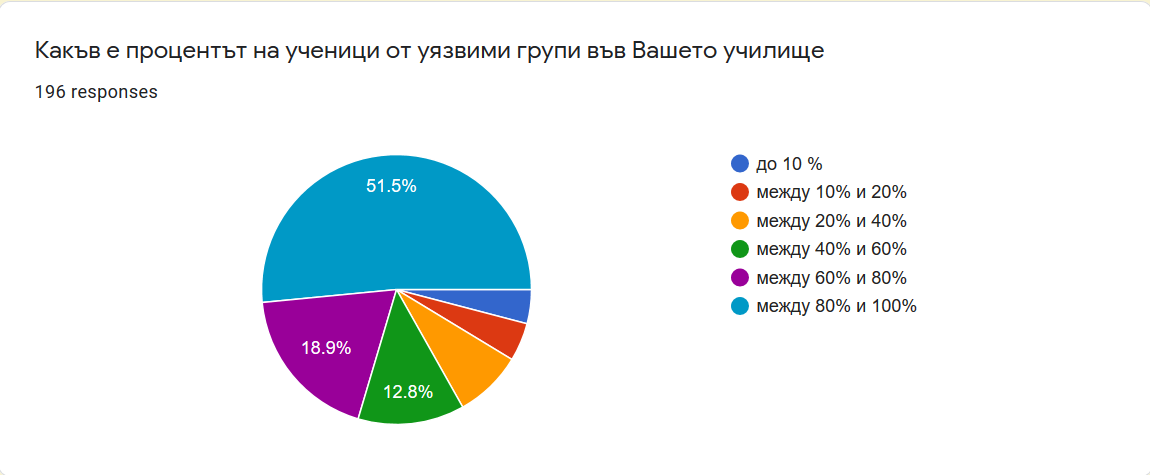
Several key findings emerge from the study:
1. The share of students enrolled in distant learning is promisingly high. Over 36% of the schools surveyed were able to reach between 75% and 100% of their students in various forms of distant learning during the first 3 days. Almost 40% of the school enrolled between 50 and 75% of the students. Given that the survey was conducted on the third day after the introduction of distant learning, these rates can be set as promisingly high. They hope that within a week or two weeks the vast majority of students in these schools will be enrolled and that pre-crisis levels will be reached.
The fact that in 17.3% of schools pupils enrolled in the first days were between one quarter and a half should not be neglected. In the coming days, their share may increase and reach normal levels, which will require more serious efforts.
We should make it clear that schools in the Network “Every Student Network will be excellent” for years, working together with the Amalipe Center to ensure full coverage and the introduction of innovative education. From this point of view, they are probably more prepared to introduce distant learning with a high percentage of students than other schools that teach students from vulnerable groups. But even though the percentage of students enrolled in other similar schools is lower, the possibility of students from lower-education families being effectively involved in distant learning is available. The big challenges in this regard are related to the technical capabilities available and of course the motivation and skills to do so.
2. There are also schools where the low enrollment rate for students in the first three days was low: in 6 schools between 10 and 25 percent of students participated, and in seven others less than 10% were enrolled. Although the percentage of these schools is relatively small - 6.6%, they do indicate problems that make distant learning virtually impossible. considering that every child and every school is important. The challenge of concentration in these schools deserves attention and focused support.
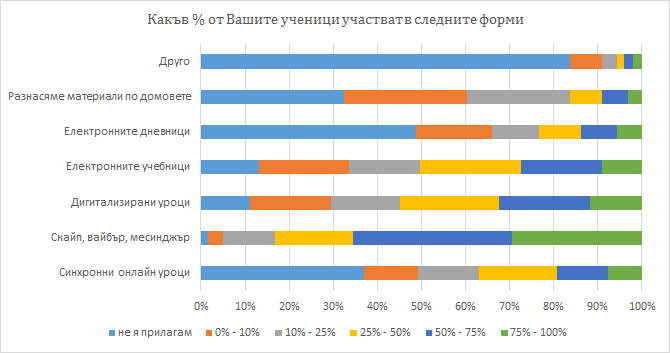
3. About distant learning, two-thirds of schools combine internet-based techniques (from assigning tasks via Skype, Messenger, etc. through the use of e-lessons to synchronous online lessons) with printing assignments and lessons and spreading them at home students. The remaining one-third (32%) of schools use only internet-based techniques. Only 3% said they relied solely on printing materials and sending them to students' homes. The combination of these two types of techniques is primarily because not all students have the necessary technical devices. This makes the task of teachers significantly more complex and they have to combine different types of techniques even within one class.
4. Non-synchronous forms of distant learning outweigh the synchronous ones, although the proportion of schools using online lessons is not small. Nearly two-thirds of schools (63%) said they were using online lessons in the first days of introducing distant learning. At the same time, only 7.6% said that they included between 76% and 100% of students in these lessons. In most schools, online lessons include one part of the students, and the rest are accessed through popular online communication tools such as Skype, Viber, Messenger and more. In 37% of schools do not use online lessons in any form and rely on other forms.
It is obvious that genuine online learning in the virtual environment is making its way, but it is still too early to talk about the possibility of it being fully implemented.
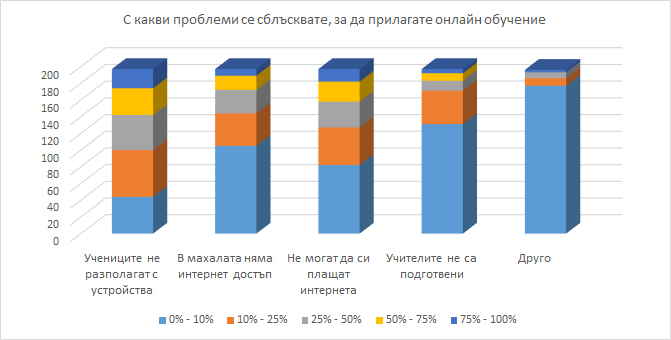
5. One of the major obstacles to the introduction of online learning is the lack of appropriate devices among many students. According to survey responses, only 22.34% of schools over 90% of students have appropriate devices. In 11.68% of schools, over 75% of students do not have the devices to participate in online learning. In two-thirds of schools, students without devices that allow effective participation is between 10% and 75%. The Ministry of Education and Science should rethink the opinion that almost all Bulgarian students have appropriate tablets, computers or smartphones. The Ministry and the schools themselves, together with their partners, should consider providing more devices to be used in the wider introduction of distant learning online.
6. The lack of internet in some of the neighborhoods in which children live is also an obstacle, although much smaller. More serious is the problem with the inability of families to afford a suitable plan with which can effectively be used online learning. Nearly 20% of schools indicated that despite the availability of the internet in the neighborhoods, most students could not afford to pay the appropriate rate. Adding to these an additional 13% of schools, who indicated that the majority of students live in neighborhoods without any internet access, this poses a relatively serious challenge. The lack of skills among some teachers is another possible reason for the lack of online training. This was cited as the least difficult, as according to the surveyed directors, in only 7% of the schools, most teachers were not able to provide online lessons.
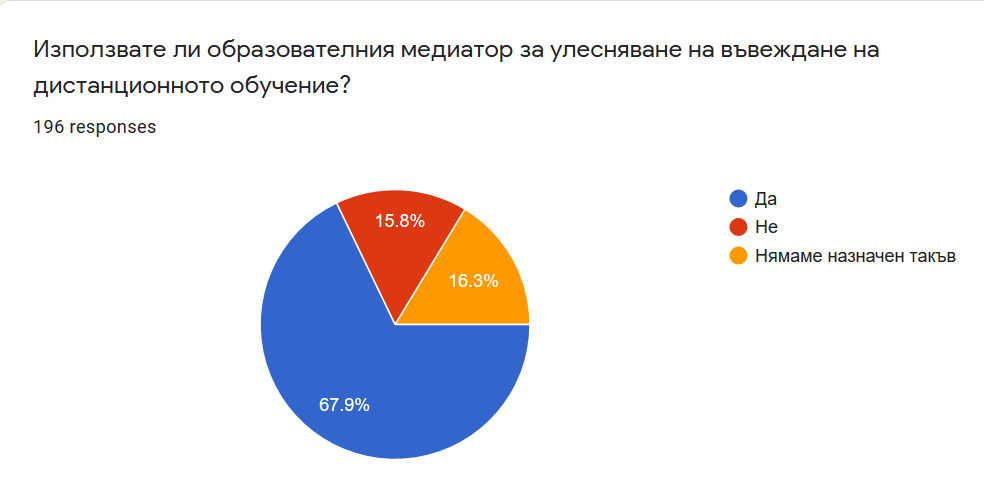
7. The educational mediator stands out as an important and frequently used teacher's aide when introducing distant learning. More than two-thirds, or 68%, of the directors who completed the survey, indicate that they have been using the educational mediator to introduce distant learning since the early days of the process. Only 16% of schools did not use a mediator for this process and in another 16% did not appoint a mediator. The fact that schools were able to appoint educational mediators through the means of working with vulnerable groups under Article 52a of the Financing Ordinance and through the Support for Success project proved a very good investment, which also facilitates the introduction of distant learning.
What is the role of the educational mediator in the first days of distant learning and emergency? In 55% of cases or 109 schools, mediators deliver printed material to students' homes, despite the threat of a coronavirus. 33% of schools indicated that their mediator was launching an information campaign for infection prevention, and another 65% indicated that the mediator provided advice on pre-assigned tasks. In one-quarter of the schools, mediators collect information about families who have returned from abroad and so on.
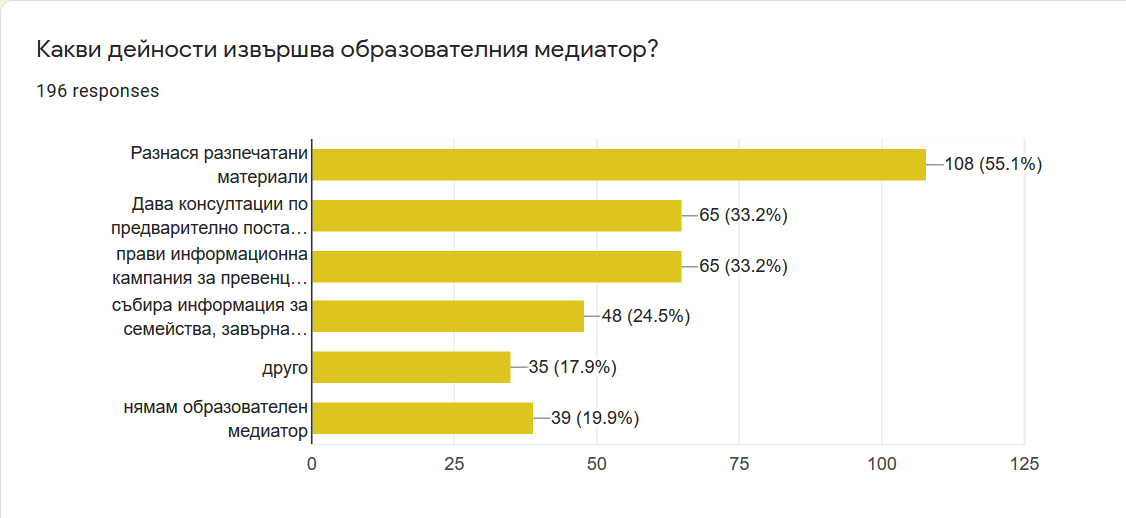
The work of the mediator quickly went beyond purely "educational" activity, and he also became involved in the ranks of frontline workers - information on methods of protection, identification of families returning from abroad who should be placed in the mandatory quarantine, etc. Most of the schools were not prepared to meet these needs and only about half responded to provide the mediators with the necessary protective equipment and disinfectants. Even they, however, said that if this situation continues for a long time, and they could not stand financially. In many other places, the mediators themselves provided or did not provide any protective equipment. The local crisis staff also did not initially recognize those people who had done an incredible job in the first, most difficult days of the state of emergency and the introduction of distant learning.
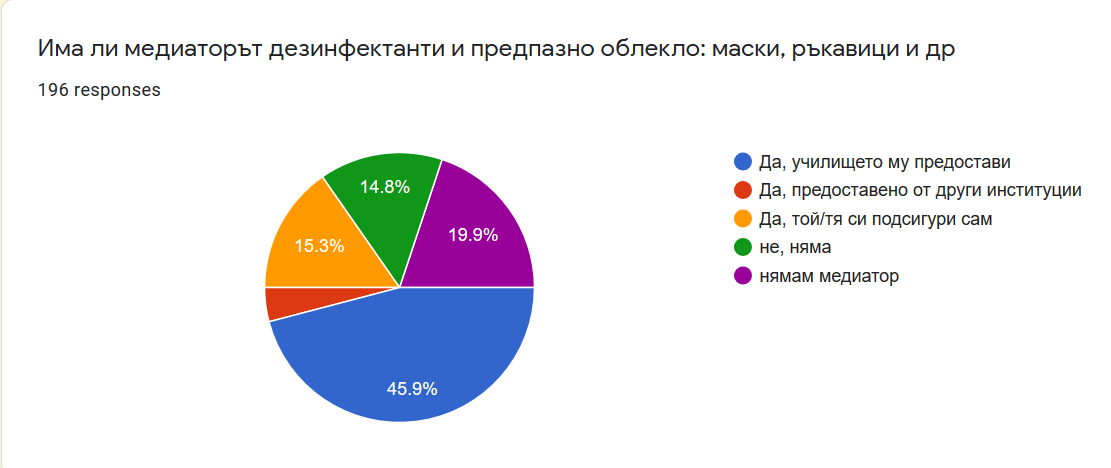
8. In the first days of introducing distant learning, half the schools are still hesitant about using this opportunity to teach new knowledge: 19% use the time only to consolidate old knowledge and practice it. another 30% are doing the same but are already considering incorporating new knowledge lessons. 22% of schools have indicated that they hold lessons for new knowledge to all students, and almost 29% - they do it with some of the students. The prospect of continuing education for a long time is pressing us and an increasing number of teachers are also moving to teaching new knowledge.
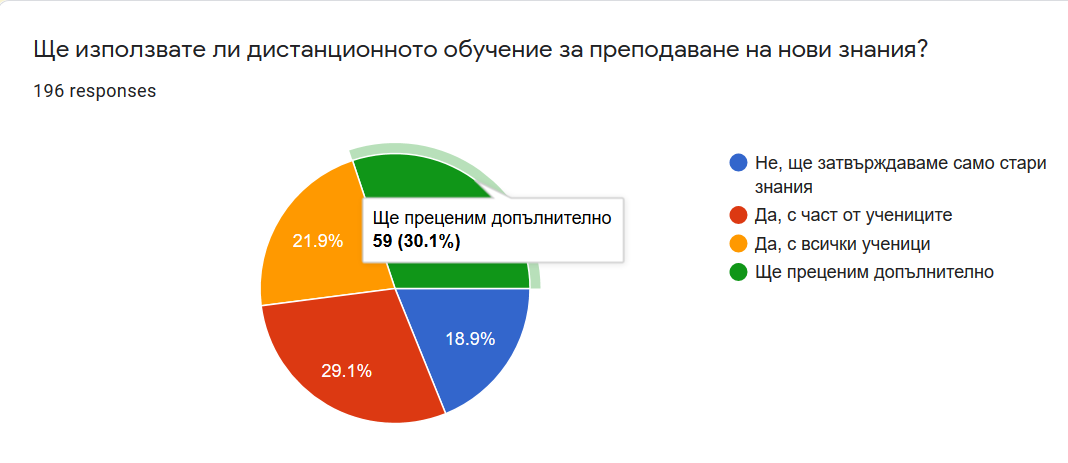
The poll does not have any claims for representative sociological research. On the one hand, it primarily involves schools with a concentration of students from vulnerable groups. On the other hand, as mentioned, schools in Network “Every Student Network will be excellent” for many years to reach the full scope and the introduction of innovative education. From this point of view, they are probably significantly better positioned than other schools teaching in similar settings. However, the survey provides clear indications of what has happened in the first days of the process of introducing distant learning in a large enough sample of schools teaching Roma students. What is inspiring is the fact that distant learning reaches a relatively large percentage of students and that many forms are used to introduce it. The efforts of teachers, principals, and educational mediators deserve real recognition and applause! Despite the suddenness and crisis, they manage to achieve enviable success. At the same time, the lack of appropriate devices and, in some places, the lack of internet, are serious obstacles that would impede the introduction of distant learning as a fully online learning experience. Because of the emerging prospect of continuing distant learning beyond March 30, the Ministry of Education, as well as other institutions involved in school education, need to provide targeted support.
However, all the figures we have listed above are just statistics, if we do not comprehend them through the emotions, experiences, and experiences of teachers, principals, parents, and students. So below we share some of the views. We hope they best immerse you in the atmosphere:
· On the first day, there were students as early as 6:30 in the morning to start their studies.
· An interesting fact is that most students are quickly converted to a wave of phone learning and are eager to contact their teachers, especially at an early stage. Previous bans and restrictions on access to their devices during school hours have been dropped altogether, and children have felt free and willing to participate in the lessons. They have even become more executive and strict.
· The organization has had to be lightning-fast, but I think we are doing well right now. In this respect, small schools are a benefit because they work in groups of classes with 3-4 children. Working in merged classes is no longer a problem.
· Students with devices are incredibly interested, but their numbers are small
· It was a great challenge for the teachers, but they managed. All colleagues report that they work far more than they do in school because now they have additional explanations with the parents of the students. It's very interesting for the students because it's different.
· A great success for us is the feedback and the parents involved.
· We have a wonderful young FV teacher who makes great videos with his daughter every day and shares them with students and parents. Then we watch clips of children and parents doing exercises at home.
· All colleagues are very responsible in this complex situation, supporting each other and helping each other. We have discovered new strengths and opportunities in ourselves and the environment in which we live. There is still a fear of the level of coping and the results of our work, but everyone is motivated to overcome the difficulties.
· We combine the two options - electronically and remotely with paper-based variants of plans, exercises, tests that are provided to parents on schedule. To our delight, parents found themselves more responsible in this situation, ready to help their children at home, or perhaps they would remember something forgotten.
· It is also good that we can count on the support of Amalipe, colleagues at the Network, who share how things happen to them.
· SUCCESS: A teacher who has always been against social networks and has never wanted to engage in this kind of communication (and doesn't know how to do it), within two days alone, with phone navigation and help from colleagues, is one of the most active in communicating with students, parents, and teachers.
· Parents who have not shown such a strong commitment to the school and what is happening to their children here are now the greatest helpers and are actively involved in all the tasks assigned by the teacher, and those of us who thought we could always count on them - it turned out that they were not so sympathetic to what was happening to their children.
· FAILURE: In families - more than two in the early stages who do not have access to the Internet but are in constant contact with the class teacher, the parent asks for help because they cannot get their child to sit and study. Without being in the classroom, the child refuses to sit behind the textbook.
· For success, I think that the classroom is working quite successfully and my colleagues are very intensively advising students on home afternoons from 2 pm to 4 pm.
· Students who have not been active during class time are now enrolled in online learning, showing great interest. Teachers are professionally supportive of one another. Teachers, students, and parents communicate in specially created groups. The failure is that with 20% of parents initially, teachers cannot communicate at all.
· The success is that I am in constant conversations with Internet service providers. I manage to arrange deferred payment for installation fees and internet connection, for an affordable subscription. I guarantee for parents who at this stage do not have the financial capacity to afford to connect to the network but will not mislead me and will be the right payers. I ordered 20 pcs. tablets that will be paid for with budget. I sought assistance in linking to a donation campaign for distant learning devices. Success may be insignificant to some! But you will understand me because I do not work remotely, I am in school! I persuade, encourage, make an effort ... He who worked on the field knows!
· My joyful conclusion is that a large number of children and parents have become involved in alternative education. I expected more disinterest and boycott of this type of training. Communication between parents and pedagogical specialists has improved.
· There are responsible students, Grade 7 Zlatka, to whom the mediator provides all worksheets for all Grade 7 students and she hands them out personally and collects feedback.
· Students with a large number of absences during the year are now very active. They are constantly on the line asking and asking!
· On day 2, we did a group in grades 5 and 6 in the vibe and gradually became aware of the students. A large number of children gradually became involved, and since most of them did not have their telephone, parents and guardians were contacted for chatting. It often happened, for example, from a parent's phone to receive a message. And because the children do not know if it is not the parent, they asked " Danes, are you?", "Desi, are you?". And in the evening, they discussed materials and links by 11 pm. I had to warn my admin administrator to enter night time.
· We got to know the students' relatives, they pass, shake hands, greet us. However, distant learning benefits. We had never seen some of them at school.
· Students are having difficulty learning online because they have one phone in the family and usually it is with the father. They are waiting for him to come home in the evening and open and show the homework sent. We have a family with one phone and the students are four, which makes it difficult for both the parent and the students. Waiting for the queue, upsetting the situation, etc.
· The story is interesting when the students call to wake up a teacher for class time at 05.30 in the morning because everyone was already on the line, but how could they not, since probably some did not go to sleep at all. The work will be successful.
· Students - passive in the real classroom, active - in the digital
· We did not expect parents to be so active. Some students were not active at school during class, but now they are interested in communicating with teachers.
· The dad of three boys complained that he could not attend all the classes.
· The parents were glad that they were students too. They said "Admiralty to all teachers". Of course, not everyone is interested in the process. E-learning runs throughout the day because students get involved at different times. They mostly work with their phones. And in some families, there are two and three children. It cannot at the same time.
· I did not expect that much activity from the students. The kids are very active, they even want to play gymnastics in the virtual classroom.
· Happier children, not an eyebrow, half to wake the phone - teacher them empty and every day to the training of educational game for feedback and different dance
· The training is provided not only to the students but also to their parents, grandparents (because they all show up for online training and all take part in it)
· During one of the geography video tutorials, a student wrote to the teacher: "Sir, does it happen that when someone is sick, instead of lazy, it is as if he is remotely learning; so he will still be clear about the lesson
· Impressive is the reaction of parents - support, interest, responsibility, excitement as to whether the child will cope, anxiety (from low literacy and lack of parents' digital skills).
· Teachers are also working to increase the literacy of parents of children from vulnerable groups. The conversations are interesting, fun, comical, a good atmosphere and a positive attitude towards children's education and the need for education for all - the road to success. Positive response from the application of distant learning. Increased empathy, closer contact with teachers, principal, increased motivation.
· Successful application of the peer education method - seventh grade to elementary students.
· The teachers are surprised by the great interest and activity of the students, including the accomplishment of the tasks assigned. The number of students enrolled in distant learning is increasing day by day. It's interesting to their children. I hope they don't get bored soon.
· Parents share their satisfaction with distant learning because it is a way for them to educate themselves with their children.
· The good thing is that for several days we feel like a big family - students, teachers, and parents.
Authors: Deyan Kolev, Teodora Krumova
-------------------------------------
* "Every student will be an excellent " is an informal network bringing together nearly 300 schools across the country. They work together to prevent dropping out of school, increase primary and secondary school enrollment, turn parents into an active participants in the educational process and introduce innovative education based on intercultural and interactive principles. The name of the network expresses confidence that every student can succeed and education is the main means of forming a successful personality. The basic concept behind the network is the belief that every child deserves to be helped; every child is good at something. This may be an area embedded in the curricula or remain outside of them. The idea of what a student is good at may be different from what we imagine to be a 'good at ...' One student may be good at math, but another may be good at being a leader and organize the others or be good at navigating the woods, or be a good musician. Our approach is:
1. To find an area in which a given student is good;
2. To help him to excel in this field by developing his knowledge and skills in a way that is acceptable to society;
3. In that, it is good to develop additional knowledge and skills in other fields covered by the curriculum, ie. to make the transition from being the student to being the other in which society wants to be the student.
The network is coordinated by the Amalipe Center with the financial assistance of the Trust for Social Alternative.








